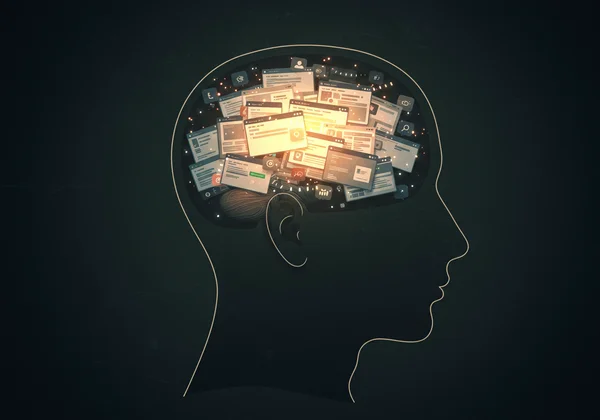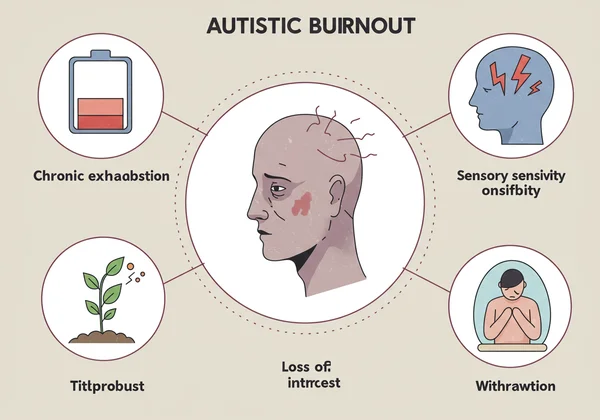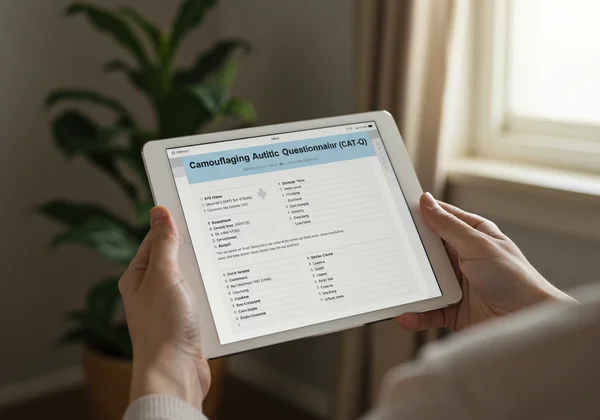Understanding Autistic Burnout: 7 Signs and How the CATQ Can Help Recovery
If you feel a profound, persistent exhaustion that sleep doesn't fix and coffee can't touch, you are not alone. It’s a feeling of being completely spent—mentally, emotionally, and physically. For many neurodivergent individuals, this goes far beyond simple tiredness. It's a state of shutdown known as autistic burnout. You may constantly be asking yourself, "Why am I so tired all the time?" The answer often lies in the immense, unseen effort of navigating a world not built for your brain, a process known as social camouflaging.
This guide will help you understand this experience by exploring the common signs of autistic burnout. More importantly, it will offer a gentle path toward recovery. The journey begins with understanding the root cause, and the first step is often identifying the very behaviors that lead to this exhaustion. You can take the first step on your journey to self-discovery today.
What is Autistic Burnout vs. Regular Burnout?
While the term "burnout" is often associated with high-stress jobs, autistic burnout is a distinct and more pervasive experience. It isn't just about being overworked; it's the result of the cumulative stress from trying to meet the demands of a neurotypical world. It’s the consequence of constantly pushing against your neurological wiring, leading to a significant loss of skills, increased sensory sensitivities, and profound exhaustion.

Think of it like a computer with too many programs running in the background. Eventually, the system overloads and crashes. For an autistic person, these "background programs" can be things like processing sensory information, manually decoding social cues, and suppressing natural behaviors (stims). When the energy required for these tasks exceeds your capacity, burnout occurs.
The Link Between Masking and Burnout
At the heart of autistic burnout is the phenomenon of social camouflaging, or "masking." This is the conscious or subconscious effort to hide or suppress autistic traits to fit in with neurotypical peers. It involves a trio of strategies: compensation (learning social rules intellectually), masking (hiding autistic behaviors like stimming), and assimilation (forcing yourself into uncomfortable social situations to appear "normal").
This constant performance is incredibly draining. Every social interaction becomes a complex algorithm of observing, analyzing, and imitating. The long-term cost of this exhausting performance is often a complete depletion of your mental and emotional resources, leading directly to burnout. Understanding your personal masking patterns is a crucial step in preventing and recovering from this state, and an online CATQ test can provide invaluable insight.
Why It’s More Than Just Feeling Tired
The exhaustion of autistic burnout is bone-deep. It’s a state where your brain and body can no longer keep up with the demands placed upon them. This often results in a noticeable loss of skills. Things you could once do easily, like managing household chores, meeting work deadlines, or even engaging in conversation, can suddenly feel impossible.
This is not a failure of willpower; it is a legitimate shutdown response. Your brain is signaling that it is out of resources and needs a drastic reduction in input and demands to recover. Recognizing that this is a neurological state, not a personal failing, is a compassionate and vital part of the healing process.
7 Common Autistic Burnout Signs
Recognizing the signs of autistic burnout is the first step toward addressing it. These experiences can vary from person to person, but here are seven common indicators that you may be experiencing more than just stress.

Sign 1: Chronic Exhaustion & Mental Depletion
This is the hallmark of autistic burnout. It's an all-encompassing fatigue that isn't relieved by a good night's sleep. You might wake up feeling just as tired as when you went to bed. This mental depletion makes even small tasks feel like climbing a mountain.
Sign 2: Increased Sensory Sensitivity
When you're in burnout, your ability to filter sensory input plummets. Lights may seem unbearably bright, everyday sounds can feel painfully loud, and textures you normally tolerate can become irritating. Your sensory system is overwhelmed, making the world feel like a constant assault.
Sign 3: Loss of Skills (Executive Function & Social)
Suddenly, your executive function skills—like planning, organizing, and starting tasks—may seem to vanish. You might struggle to make decisions or remember things. Socially, you may lose the ability to make small talk or interpret social cues, skills you previously managed through intense effort.
Sign 4: Reduced Capacity for Socializing
Your "social battery" is not just low; it's completely drained. The thought of interacting with people, even friends and family, can feel overwhelming. You might find yourself canceling plans and isolating yourself because you simply do not have the energy for social performance.
Sign 5: Heightened Emotional Responses
With your defenses down, your ability to regulate emotions is significantly reduced. You may find yourself becoming overwhelmed, irritable, or tearful more easily. Meltdowns or shutdowns might become more frequent as your system struggles to cope with stress.
Sign 6: Loss of Interest in Passions
One of the most distressing signs can be a loss of joy in your special interests or hobbies. Activities that once brought you comfort and excitement may now feel like another chore. This happens because the energy required to engage with anything, even things you love, is gone.
Sign 7: A Need for Complete Withdrawal
This is an intense, instinctual need to retreat from the world. You may feel an overwhelming urge to be alone in a quiet, dark room, free from all demands and stimulation. This is your brain's way of demanding the deep rest it needs to begin healing.
How to Recover From Autistic Burnout: A Gentle Start
Recovering from autistic burnout is a process of radical rest and self-compassion. It's about removing demands, not adding more. Here are three gentle steps to begin your journey toward recovery.
Step 1: Conduct an "Energy Audit" to Reduce Demands
Take an honest look at your life and identify what drains your energy. This could be social obligations, specific work tasks, or even sensory aspects of your environment. Be ruthless in eliminating, reducing, or modifying these drains wherever possible. This is not selfish; it is essential for your survival and recovery.
Step 2: Embrace Sensory Regulation and Stimming
Allow yourself to engage in activities that soothe your nervous system. This means embracing stimming (rocking, fidgeting, etc.) without shame, as these are natural self-regulation tools. Create a sensory-friendly environment by using noise-canceling headphones, sunglasses, or weighted blankets. Give your body what it needs to feel safe.
Step 3: Identify Your Masking Triggers with the CAT-Q
Recovery isn't just about resting; it's about preventing the next burnout. The key is to understand what drains your energy in the first place, and that is almost always tied to camouflaging. The Camouflaging Autistic Traits Questionnaire (CAT-Q) is a scientifically validated tool designed to help you identify and quantify your unique masking behaviors. By taking the free, scientifically-validated CATQ test, you can gain clarity on which situations and behaviors are costing you the most energy. This knowledge empowers you to make conscious choices about where and when you use your precious resources, paving the way for a more authentic life.

Feeling seen in these descriptions is the first sign that you're on the right path. Autistic burnout is a real, debilitating experience, but it is not a life sentence. It is a powerful signal from your mind and body that the cost of masking has become too high. Recovery is possible, and it begins with radical rest, self-compassion, and a commitment to understanding your authentic self.
The journey away from burnout starts with knowledge. Understanding the "why" behind your exhaustion is incredibly empowering. Discover your unique camouflaging profile and start your assessment to take a meaningful step toward reducing your mental load and living a life that honors your true neurotype.
We invite you to share your thoughts or experiences in the comments below—your story matters.
FAQs About Autistic Burnout and Masking
How do I know if I'm masking autism?
If you feel like you're constantly "acting" in social situations, meticulously plan conversations beforehand, or feel utterly exhausted after socializing, you are likely masking. Other signs include mimicking others' body language, forcing eye contact that feels uncomfortable, or suppressing strong interests to fit in. The most definitive way to explore this is to use a structured tool designed to measure these behaviors. The CATQ online test is a great starting point for self-reflection.
What is the difference between masking and camouflaging?
The terms are often used interchangeably, but "camouflaging" is the broader, research-based term. It encompasses three core strategies: Compensation (learning social skills intellectually), Masking (hiding autistic traits like stimming), and Assimilation (forcing oneself into neurotypical social situations). Masking is just one component of the overall camouflaging effort.
Can I be autistic and not know it?
Yes, absolutely. This is particularly common for adults, especially women and individuals in the LGBTQ+ community, who became adept at camouflaging from a young age to survive socially. Many people don't realize they are autistic until they experience a major life event, such as burnout, which makes their previous coping strategies unsustainable. If you've always felt "different" but can't pinpoint why, exploring the possibility of autism is a valid path to self-understanding. You can discover your results and gain deeper insights.
Disclaimer: This article is for informational and self-exploration purposes only. The CATQ test is a self-assessment tool, not a diagnostic instrument. It cannot replace a professional evaluation by a qualified healthcare provider. If you are seeking a diagnosis, please consult a medical professional.